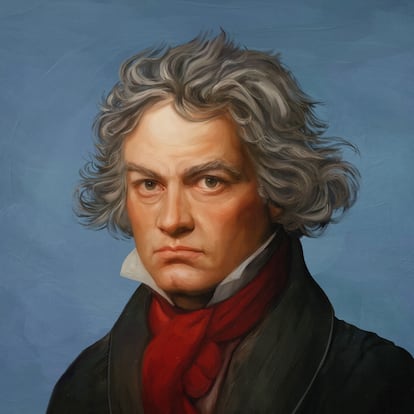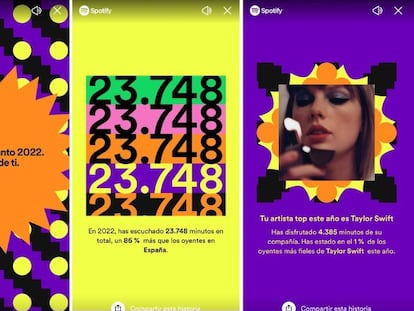The algorithm has reconciled with classical music
Difficulty in finding specific recordings on streaming platforms has led Apple to develop an application capable of selecting reference versions from dozens of releases

Music has become liquid in the age of access, wrote Italian tech journalists Gianluigi Bonanomi and Renzo Zonin in their 2014 book, Musica liquida. They borrowed the expression from sociologist Zygmunt Bauman, who first used it to describe the rising tide of streaming music offered by online platforms like Spotify and Deezer that was quickly submerging the reliable compact disc.
Bonanomi and Zonin’s book explores the commercial transformation of property into access, alluding to American economist Jeremy Rifkin’s theories in The Age of Access (2001). It’s a new world where large commercial networks rent online content for a subscription fee, and where we no longer talk about buyers and sellers, but about users and providers. Since Rifkin wrote his book over 20 years ago, this reality quickly spread to audiovisual products offered by Netflix and other, and to digital books (audiobooks and ebooks from Storytel and others).
But the age of access was better suited to popular music because streaming platforms categorize music using very few attributes (or metadata): artist, album name and song title. These three attributes are enough to find a track by Rosalia or Beyoncé quickly, but not a specific recording of Beethoven’s Emperor Concerto. Dozens of performers have recorded this composition, and some more than once. A streaming music platform should at least allow searching by composer, composition, catalog number, movement and performers.
Apple came to the rescue when it launched a new iPhone application on March 28 called Apple Music Classical. The tech giant realized it needed a solution when it rolled out a new Apple Music feature in May 2021 called “spatial audio” (using Dolby Atmos) that provides an immersive sound experience similar to Deezer’s 360 Reality Audio and Tidal’s audio quality. Apple Music also began offering lossless high-resolution sound files without increasing subscription fees, unlike other platforms.
#AppleMusicClassical is here! Watch as two of the most powerful talents in classical music, @AliceSaraOtt and @kcanellakis, team up to introduce you to the new app. https://t.co/lwnF4Dx4ua pic.twitter.com/cbEbageOha
— Apple Music Classical (@AppleClassical) March 28, 2023
A few months later, Apple bought Primephonic, an Amsterdam-based startup offering a streaming classical music experience through an attractive and intuitive app that addressed the metadata problem. Primephonic specialized in classical music and was helmed by Guy Jones, a former head of digital projects at the London Symphony and creator of Touchpress’s successful classical music apps The Orchestra and Beethoven’s 9th Symphony.
Apple Music Classical leveraged the Primephonic team’s expertise to provide an enhanced experience for classical music lovers. It’s now easier to find a classical album with just a few search terms. For example, entering “Beethoven 5 Uchida” instantly produces the two recordings of the Anglo-Japanese pianist’s performances, and recommends other recordings of the same composition. Apple Music Classical has the largest online catalog of classical music –five million tracks versus Spotify’s two million. It includes no less than 971 recordings of the Emperor Concerto, some in high-definition and Dolby Atmos.

However, there’s still some work to be done. Apple’s catalog does not distinguish between recordings and releases, as the same classical recording can have multiple editions. It confuses the recording year with release year, and doesn’t distinguish complete compositions and fragments, unlike the IDAGIO platform. In fact, the 917 versions of the Emperor Concerto in Apple Classical Music’s search results include dozens of duplicates and fragments. While Apple’s high definition claims to reach a 192 kHz sampling frequency, in reality, it almost never exceeds 44.1 kHz (the same as a CD). Other platforms like Qobuz have much better high-definition catalogs.
Apple Music Classical’s jewel in the crown is its browser, a new feature that offers an admirable navigation system specially designed for classical music. A user can search by catalog, playlist or instrument, and then choose to search by composer, period, genre or performer (conductors, orchestras, soloists, ensembles and choirs). A search of Johann Sebastian Bach produces three popular compositions, along with the latest releases and a brief biography. But something interesting happens when we tap on “View all 1224 works.” We can access his entire musical output and sort it by BWV number (a number that uniquely identifies a Bach composition), popularity, name and tonality. Then we can filter the results by genre (orchestral, vocal, etc.).
The catalog of playlists is immense – one can search by mood, must-have recording (by composers and performers), historical period, instrument and ensemble. There are also playlists created by the artists themselves with short, text descriptions of the listening experience. For example, violinist Joshua Bell has an engaging personal playlist called “Life-changing music,” and cellist Yo-Yo Ma created one appealing to human connections called “What unites us.”

The “Listen” menu offers another path to playlists, new releases and various editorial selections such as must-have albums, albums we love and hidden gems. Beginners will find a Guy Jones-narrated history of podcast music called The Story of Classical. Knowledgeable aficionados can access a series of exclusive recordings in Dolby Atmos thanks to Apple’s licensing agreements with the world’s leading orchestras and opera houses.
The “Song by song” feature (why not call it “Track by track”?) offers performer commentaries on their own recordings, like Hilary Hahn discussing her latest Bach solo violin album (Decca). Everything in this new application bears the Apple quality and design imprimatur. Dozens of covers were created for playlists, including 55 exclusive digital portraits of major composers. Instead of Apple Music’s usual San Francisco font, the New York font gives the app a retro look and feel.
This new app from the Cupertino, California tech giant substantially improves the classical music experience in the age of (streaming) access. Beginners can quickly find their way, veterans can easily locate favorite recordings, and experts can explore new horizons.
Sign up for our weekly newsletter to get more English-language news coverage from EL PAÍS USA Edition
Tu suscripción se está usando en otro dispositivo
¿Quieres añadir otro usuario a tu suscripción?
Si continúas leyendo en este dispositivo, no se podrá leer en el otro.
FlechaTu suscripción se está usando en otro dispositivo y solo puedes acceder a EL PAÍS desde un dispositivo a la vez.
Si quieres compartir tu cuenta, cambia tu suscripción a la modalidad Premium, así podrás añadir otro usuario. Cada uno accederá con su propia cuenta de email, lo que os permitirá personalizar vuestra experiencia en EL PAÍS.
¿Tienes una suscripción de empresa? Accede aquí para contratar más cuentas.
En el caso de no saber quién está usando tu cuenta, te recomendamos cambiar tu contraseña aquí.
Si decides continuar compartiendo tu cuenta, este mensaje se mostrará en tu dispositivo y en el de la otra persona que está usando tu cuenta de forma indefinida, afectando a tu experiencia de lectura. Puedes consultar aquí los términos y condiciones de la suscripción digital.
More information
Archived In
Últimas noticias
Most viewed
- Alain Aspect, Nobel laureate in physics: ‘Einstein was so smart that he would have had to recognize quantum entanglement’
- Mexico’s missing people crisis casts a shadow over World Cup venue
- Why oil has been at the center of Venezuela-US conflicts for decades
- Trump clarifies who is ultimately in charge in Venezuela: ‘Me’
- Mexico seeks to shore up its defenses following US incursion in Venezuela










































